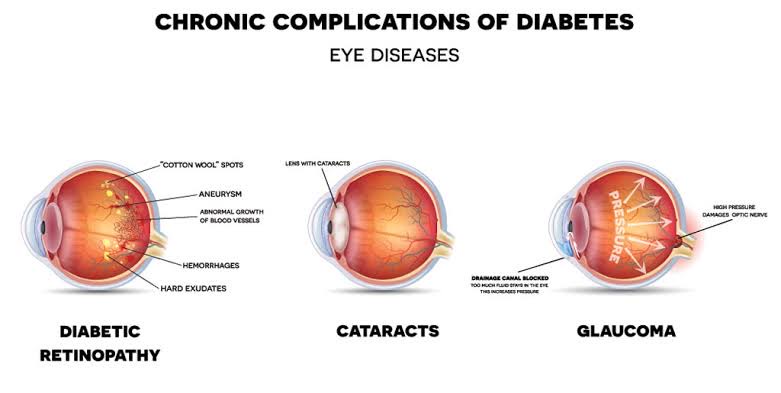
Diabetes is a disease in which glucose levels in your blood (also known as blood sugar) are high. Blood
glucose is your body’s main source of energy and you get it from the food you eat. Your body makes a
hormone called insulin that helps glucose from food you eat get into your cells to be used for energy. If
you have diabetes, your body may not make enough insulin or any insulin or your body is not able to use
insulin well. This causes glucose to stay in your blood and not get to your cells for energy.
Many people are able to live long and healthy lives with diabetes. You can manage diabetes through
diet, exercise and taking medication as prescribed. Without management, the high glucose levels in your
blood can cause damage to your heart, kidneys, feet, ears, and eyes. Staying healthy will make it easier
for you to manage your diabetes and maintain good vision and eye health.
You are more likely to have diabetes if you are:
• 45 or older
• Have a family history of the disease
• High blood pressure
• Have excess weight
The good news is that you can manage diabetes by taking good care of yourself through healthy meal
planning, regular exercise, and taking medication as prescribed.
EYE DISEASES THAT CAN BE CAUSED AS A RESULT OF DIABETES
Diabetes patients are susceptible to developing following eye diseases. “All of these conditions can
cause vision loss, but early detection and treatment can greatly improve and preserve your sight." These
diseases include:
* Diabetic Retinopathy
* Macular Edema (which typically occurs in conjunction with diabetic retinopathy)
* Cataract
* Glaucoma
1. Diabetic retinopathy
Diabetic retinopathy is a condition that occurs when the blood vessels in the retina swell, break, and
bleed. High blood sugar levels trigger this condition.
The retina is the part of your eye that transmits signals to your brain. Without your retina, your brain
cannot interpret images, even though your eye can perceive light and images.
When there’s damage to your retina, you start having trouble with your vision. Symptoms of diabetic
retinopathy include:
• Blurry or wavy vision
• Difficulty seeing at night or in dim lighting
• Changes in vision quality
• Darkened or empty spots in your field of vision
• Loss of side or peripheral vision
• Presence of “floaters”
• Without treatment, diabetic retinopathy can lead to permanent vision loss.
2. Macular edema
Diabetic macular edema is an eye condition where the macula becomes swollen. The macula is the part
of the eye responsible for sending the best resolution images to your brain. It is locatednear the center
of the retina and is essential for central vision.
Blood vessels in the retina can grow new abnormal blood vessels. These vessels can also tear and leak
fluid into the macula. This causes the macula to swell (“edema”), which can make your central vision
appear blurry or wavy.
3. Glaucoma
Glaucoma occurs when there’s damage to the optic nerve (the nerve that connects the retina to the
brain). This is usually due to high pressure inside the eye. When the optic nerve is damaged, you will
experience vision loss. If there’s enough damage, you can lose your sight permanently.
Diabetes causes one form of glaucoma. High sugar levels can sometimes cause so much damage to the
retina’s blood vessels that the body has to make new ones. If the new blood vessels grow on the iris (the
colored part of your eye), it will cause your eye pressure to increase. And that can lead to glaucoma that
is difficult to control.
4. Cataracts
Cataracts form as the lens of your eye becomes cloudy. Cataracts develop naturally over time. People
with diabetes can develop cataracts sooner without good control of their blood sugar.
Overall, people with diabetes are twice as likely to develop cataracts than people without diabetes.
HOW CAN I PROTECT MY EYES IF I HAVE DIABETES?
There are several things you can do to protect your eyesight:
• Keep good blood sugar control: High blood sugar levels increase your risk of developing these eye
conditions. The risk goes up the longer you have diabetes.
• Get a yearly eye exam: If you have diabetes, make sure you get a complete eye exam every year. Your
eyecare provider will dilate your pupils and check your retinas to look for signs of diabetic changes.
• Wear sunglasses: Exposure to UVA and UVB rays can speed up cataract development. Use sunglasses
that offer protection from UVA and UVB rays (even if it’s overcast).
• Keep your blood pressure in target ranges: High blood pressure can cause damage to the blood
vessels in your eyes and lead to retinopathy. If you have high blood pressure, use your medication and
follow up with your healthcare provider to make sure your blood pressure stays in your target range.
• Stop smoking: Smoking causes damage to your blood vessels, which can worsen eye conditions like
retinopathy.
If you notice any vision changes or unusual symptoms with your eyes — such as pain, frequent redness,
double vision, or eye pressure — see your eye doctor as soon as possible.
